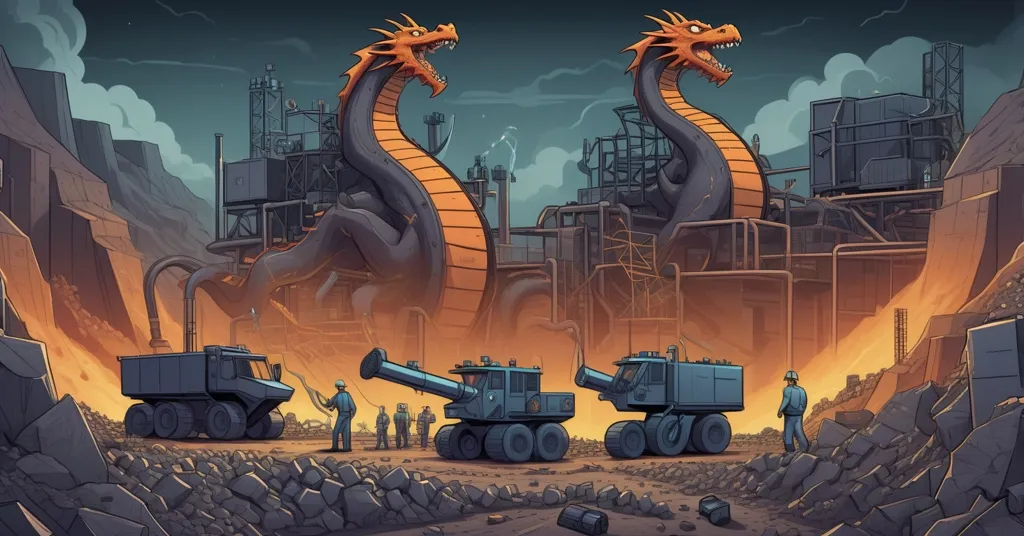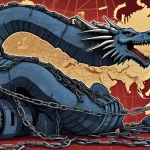Pentagon’s $1B Mineral Stockpile: Bitcoin Mining and Crypto Tech Face Supply Chain Risks

Pentagon Stockpiles Minerals Amid China Export Curbs: A Wake-Up Call for Bitcoin and Crypto Tech
The Pentagon is making a bold move with a $1 billion mineral stockpile program to cut U.S. dependence on China for critical materials vital to defense and technology, including the hardware that powers Bitcoin mining and blockchain networks. As Beijing tightens its grip on rare earths and other key resources with export restrictions, this geopolitical chess game is sounding alarms far beyond military corridors—straight into the heart of decentralized tech.
- Strategic Buffer: Pentagon’s $1 billion initiative targets minerals like cobalt and rare earths to counter China’s export curbs.
- Market Chaos: Beijing’s restrictions double prices of materials like antimony, threatening global supply chains.
- Crypto at Risk: Bitcoin mining rigs and blockchain infrastructure face potential disruptions from this resource war.
The Mineral Crunch: What’s at Stake
Let’s cut through the noise. The U.S. is in a precarious spot, heavily reliant on China for critical minerals that are the lifeblood of everything from fighter jets to the ASICs (Application-Specific Integrated Circuits) hammering away at Bitcoin’s blockchain. These materials—think cobalt for batteries, rare earth elements for high-powered magnets, antimony trioxide (a compound used in flame retardants and munitions), and germanium (a metal key for optics and electronics)—aren’t just industrial trivia. They’re the foundation of modern tech, including the servers and cooling systems that keep decentralized networks humming. China controls a massive chunk of global production, with estimates pegging their hold at 60-70% for rare earths alone. That’s a stranglehold, and Beijing knows it.
Recently, China slapped sweeping export restrictions on these materials and related technologies, a move that smells like pure economic warfare amid simmering tensions with the West. The fallout has been immediate: antimony trioxide prices have nearly doubled, germanium shipments have cratered, and industries from automakers to tech giants are scrambling for substitutes. This isn’t just a blip—it’s a deliberate flex of power, and the U.S. is feeling the heat, as detailed in reports about the Pentagon’s expanded mineral deals. National security is on the line, sure, but so is the stability of the tech ecosystem that underpins blockchain innovation. If you thought Bitcoin’s biggest headache was regulatory FUD, think again. Hardware supply chains are the silent Achilles’ heel of decentralization.
Pentagon’s Play: Stockpiling for Security
The Pentagon isn’t sitting idle. Through the Defense Logistics Agency (DLA), it’s building a war chest of critical minerals to insulate against China’s supply squeeze. The shopping list is hefty: $500 million in cobalt, $245 million in antimony from U.S. Antimony Corporation (USAC), $100 million in tantalum, and $45 million in scandium from suppliers like Rio Tinto and APL Engineered Materials. A deal with USAC secures 3,000 tonnes of antimony metal—enough for national emergencies, though it’s a fraction of the U.S.’s annual 24,000-tonne consumption. The DLA already holds $1.3 billion in alloys and ores as of 2023, locked away for wartime crises, but this new push signals a shift from precaution to urgency.
President Donald Trump is throwing his weight behind the effort, threatening a jaw-dropping 100% tariff on all Chinese imports as a counterpunch to Beijing’s restrictions. He’s delayed enforcement until November 1, hedging with a vague “we’re gonna have to see what happens,” and hinted at a possible meeting with Chinese President Xi Jinping in South Korea to cool tensions. Trump didn’t hold back on China’s tactics, declaring:
“There is no way that China should be allowed to hold the world captive, but that seems to have been their plan.”
But the bravado isn’t unanimous. A former U.S. official called the tariff delay a “typical Trump backpedal,” while Wang Wen from Renmin University in China sneered at U.S. threats, labeling America a “paper tiger.” Meanwhile, Trump’s proposed “One Big Beautiful Bill Act” allocates $7.5 billion to bolster mineral reserves, with $2 billion for the national defense stockpile, $5 billion for supply-chain investments, and $500 million for a Pentagon credit program to spur private sector involvement. Sounds ambitious, but will it dig the U.S. out of China’s mineral chokehold? That’s the trillion-dollar question.
Stephanie Barna, a lawyer at Covington & Burling in Washington, laid out the stakes starkly:
“China’s control over these minerals would have a direct, palpable and adverse effect on U.S. ability to field the kind of high-tech capabilities needed for any strategic competition or conflict.”
A mining sector executive echoed the desperation, noting:
“The government knows how critical this stuff is and wants to support whatever domestic capacity exists.”
Yet, building domestic capacity or tapping allies like Australia and Canada isn’t a quick fix. Mining these minerals is a dirty, expensive grind—think toxic sludge, energy guzzling, and local backlash. And here’s the bitter irony: even as the U.S. hoards resources to defy Beijing, much of its tech sector, including components for blockchain hardware, still leans on Chinese manufacturing. It’s a messy knot to untangle.
Crypto Caught in the Crossfire
Now, let’s zero in on why this matters to the crypto crowd. Critical minerals aren’t just Pentagon priorities—they’re the bedrock of the hardware that secures Bitcoin’s network and powers blockchain ecosystems. Bitcoin mining rigs, particularly ASICs, rely on rare earth magnets for cooling systems and cobalt for battery backups in data centers. Ethereum’s data-intensive dApps and other altcoin projects lean even harder on sprawling server farms, all hungry for the same materials. A supply disruption doesn’t just mean pricier smartphones; it could mean delayed production of mining gear, skyrocketing costs for miners, and even slower transaction confirmations or higher fees for everyday BTC users holding in their wallets.
Remember the 2021 chip shortage? It crippled industries, including crypto mining, as hardware became scarcer than a Satoshi sighting. Miners faced months-long delays for new rigs, and second-hand gear prices went through the roof. China’s export curbs could trigger a similar nightmare, even if much Bitcoin mining has shifted out of the country post-ban. Why? Because the supply chain for components—often sourced or processed in China—remains a bottleneck. A spike in antimony or cobalt prices doesn’t care where your mining farm is; it hits your bottom line regardless. And for blockchain startups pushing new protocols, a hardware crunch could choke innovation before it even starts.
The Pentagon’s stockpile might offer a lifeline by stabilizing access to these materials for U.S.-based tech manufacturing, indirectly supporting the crypto hardware pipeline. But don’t pop the champagne yet—it’s a slow burn, not a magic bullet. Short-term volatility is still a real threat, and if Trump’s tariff threats spark retaliatory export bans from China, we could see shortages worsen before they improve. For a space that prides itself on sovereignty, this is a glaring reminder: your node might be decentralized, but your hardware supply chain sure as hell isn’t.
Decentralization vs. Geopolitical Chains
Let’s play devil’s advocate for a moment. Some might argue the crypto industry’s global nature—miners scattered across continents, nodes everywhere—shields it from single-point failures like a U.S.-China spat. Bitcoin, after all, isn’t tethered to one nation’s policy. Fair point, but it’s naive to ignore the reality: hardware production is still heavily concentrated. Many ASIC manufacturers, even if not based in China, depend on Chinese-processed materials or components. A geopolitical snarl doesn’t need to shut down mining farms to hurt; it just needs to choke the pipeline of new rigs or replacement parts. True decentralization? Not until we break free from these centralized resource traps.
From a Bitcoin maximalist lens, this mess hits hardest at the backbone of real decentralization—BTC’s mining network. Altcoin projects with bloated infrastructure might flounder under supply shocks, but Bitcoin’s leaner design doesn’t make it immune; it just means the pain is more existential. If mining hardware becomes a luxury good, centralization creeps in as only the big players can afford to hash. Yet, there’s a sliver of hope in altcoins’ experimental streak—some might pioneer workarounds like lighter consensus mechanisms that sidestep hardware gluttony, feeding back into the broader ecosystem.
Looking through the lens of effective accelerationism (e/acc), this crisis should be a cattle prod for crypto innovators. Why not double down on energy-efficient mining tech or hardware recycling to shrink our mineral footprint? Imagine a future where Bitcoin rigs are cobbled from reclaimed rare earths, not fresh-mined ore. It’s a long shot, but if we’re serious about accelerating decentralization, we can’t keep leaning on centralized resource bottlenecks. The U.S. stockpile is a band-aid—a centralized fix to a centralized problem. Real freedom comes from tech that laughs in the face of geopolitics, much like Bitcoin laughs at fiat printers.
One last jab: don’t fall for any talking heads claiming this mineral mess will “moon” Bitcoin prices. It’s a hardware issue, not a hodl signal. The market might twitch on news of tariffs or curbs, but that’s just noise. Focus on the fundamentals—how do we build a crypto world that doesn’t buckle under a trade war? That’s the fight worth hashing out.
Key Questions and Takeaways
- How do critical minerals impact Bitcoin mining and blockchain technology?
These minerals, such as cobalt and rare earths, are essential for Bitcoin mining hardware like ASICs and blockchain infrastructure components including servers and cooling systems. Disruptions in supply could delay production, increase costs, and threaten network security or scalability. - What risks do China’s export restrictions pose to the crypto industry?
Restrictions on materials like antimony and germanium could disrupt supply chains for mining rigs and data centers, even with mining operations largely outside China. Resulting hardware shortages or price spikes could hinder growth in decentralized tech. - Can the Pentagon’s stockpile program stabilize crypto hardware supply chains?
It’s possible, as the $1 billion initiative aims to secure materials for tech manufacturing, indirectly aiding Bitcoin mining and blockchain projects. However, it’s a gradual effort, and short-term supply volatility remains a concern. - Why should the crypto community care about U.S.-China resource tensions?
This conflict exposes a weak link in decentralization—hardware dependency. If supply chains are controlled by centralized powers, true sovereignty for Bitcoin and other networks is at risk, underscoring the need for diverse sourcing. - Could innovation in crypto tech reduce reliance on critical minerals?
Absolutely, through energy-efficient mining designs or hardware recycling initiatives, the industry could lessen its mineral dependency. Embracing effective accelerationism, crypto innovators must push beyond centralized resource constraints to build resilience.
Zooming out, this mineral standoff mirrors the ethos of Bitcoin itself—don’t trust, verify, and never let one entity hold all the keys. The Pentagon’s scramble for resource independence echoes the crypto fight against centralized control, but let’s not get too cozy with government solutions. Building resilience in supply chains, like scaling Bitcoin or fostering blockchain innovation, is a grind full of trade-offs. If the U.S. can pull this off without tripping over its own tariffs or alienating allies, it might carve out a sliver of freedom from Beijing’s grip. For us in the crypto trenches, it’s a stark reminder: every step toward decentralization—whether in money or materials—is a battle worth waging. Because if Bitcoin miners ever have to scavenge rare earths like dystopian prospectors, we’ve already lost the war.



